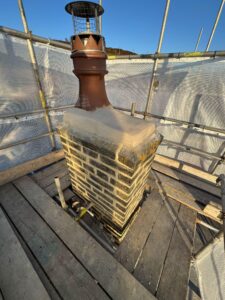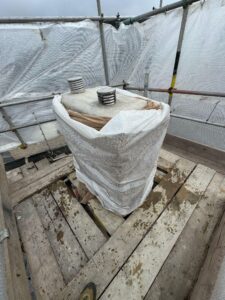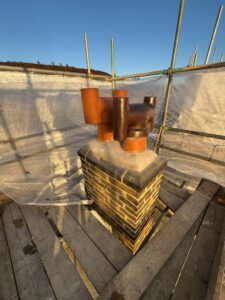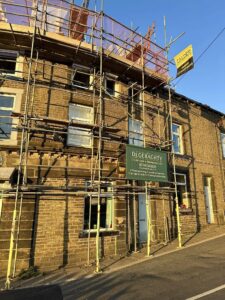declanjohn@djgeraghty.co.uk
07745 185028
Four chimneys across three houses
Introduction to the Restoration Project
The restoration of the four chimneys, located across three heritage houses, highlights the critical importance of preserving historical architecture and maintaining our cultural heritage. These chimneys are not merely functional features; they are key markers of the architectural style and craftsmanship of their time. As custodians of our built history, it is vital to safeguard such structures so future generations can appreciate the artistry and historical narratives they represent.
This project was launched with the aim of restoring the chimneys to their original condition, while ensuring both architectural integrity and historical accuracy. The scope of the work included extensive research to understand original construction techniques, materials, and design features. A thorough assessment of each chimney was undertaken, revealing various challenges. Years of exposure to the elements, erosion, and neglect necessitated a careful and considered restoration strategy.
The obstacles encountered underscored the importance of meticulous planning and skilled craftsmanship. The project team—comprising specialists in heritage architecture—faced technical difficulties such as limited access and the fragile condition of the existing structures. These challenges highlighted the need for best practices in heritage conservation and close collaboration between architects, conservationists, and skilled tradespeople. The goal was not only to restore the chimneys but to breathe new life into the stories they embody, encouraging a deeper appreciation for heritage preservation.

Detailed Restoration Process
The restoration of heritage chimneys is a precise and considered process, balancing the preservation of historical authenticity with the need for structural soundness. The first step involves the careful removal of defective flaunching, which, if left unaddressed, can lead to water ingress and further damage. As flaunching serves to protect chimney pots, its removal must be undertaken with particular attention to the surrounding structure to avoid causing additional harm.
Once the flawed flaunching has been removed, the chimney pots are securely supported and realigned. This not only prevents potential hazards but also ensures that the chimney retains its aesthetic and functional integrity. Skilled hands are essential at this stage to guarantee that the pots are correctly positioned, facilitating effective water run-off.
The next phase involves installing new flaunching. This is formed into a single, cohesive unit designed to be both durable and weather-resistant. Care is taken to use high-quality, historically appropriate materials to preserve the authenticity of the restoration. The new flaunching safeguards against moisture ingress and prolongs the life of the chimney.
An integral part of the process also includes addressing damaged stonework and inappropriate cementitious pointing. The removal of cement-based materials must be executed with precision, and replaced using lime mortar—a preferred choice in heritage restoration due to its flexibility and breathability. These qualities allow the structure to respond to environmental changes without cracking. Traditional techniques are employed throughout the rebuilding and repointing phases, showcasing the expertise required for a lasting and respectful restoration. Each stage of the work reflects a commitment to quality craftsmanship, ensuring the chimneys endure as both functional structures and historical artefacts.



Scaffolding and Its Importance in Chimney Renovation
Scaffolding plays a crucial role in the restoration of heritage chimneys, offering both access and safety. Individual scaffolding for each chimney is essential, providing a stable working platform at various heights and allowing the restoration team to reach all necessary areas without compromising safety or the structural integrity of the building.
Erecting and dismantling scaffolding must be carried out by trained professionals to ensure compliance with safety regulations and to minimise risk. The scaffolding must be tailored to the specific demands of each chimney, taking into account weight distribution, height, and site accessibility. Failure to address these considerations could endanger workers or damage the structure itself.
Additional logistical planning is required once chimney works are completed, particularly concerning roof repairs. Restoring a heritage chimney often requires the surrounding roof area to be inspected and potentially repaired. Close coordination between contractors and scaffolders ensures that scaffolding remains in place until all associated work is complete. By prioritising the role of scaffolding, the project not only achieves its restoration objectives but also protects the historical value of these important architectural elements.

Outcome and Team Efforts
The successful restoration of the heritage chimneys stands as a testament to the dedication, teamwork, and expertise of all involved. The team overcame numerous challenges—ranging from difficult weather conditions to deteriorating materials—demonstrating both technical proficiency and a strong spirit of collaboration.
Through a well-coordinated approach, the team was able to adjust to unforeseen circumstances and maintain the high standards required for heritage restoration. For example, during periods of poor weather, work schedules were adapted and protective measures put in place to safeguard both the workers and the structures. This level of adaptability was essential to maintaining the quality and continuity of the restoration process.
The outcome is both visually striking and structurally sound. The chimneys now reflect their original design and craftsmanship, enhancing the overall character of the heritage properties. The use of traditional materials and techniques has ensured historical accuracy while improving long-term durability. As a result, these restored chimneys not only preserve the integrity of the buildings but also strengthen public appreciation for our architectural heritage.
Ultimately, the project represents a collective commitment to preserving the past for future generations. The pride and satisfaction taken in overcoming the restoration’s challenges is matched only by the value it brings to our shared cultural legacy.
About Us
We are DJ. Geraghty Construction & Maintenance, a local family run business in the Calder Valley, dedicated to delivering high-quality construction services with exceptional customer care. We specialise in traditional roofing of heritage and listed buildings, heritage renovations and conversions, and modern new builds and extensions. Experience the DJ. Geraghty difference – where craftsmanship meets excellence.
Follow Us
Find Us
Unit B1, Tenterfields Business Park, Luddenden Foot Hebden Bridge, HX2 6EQ
